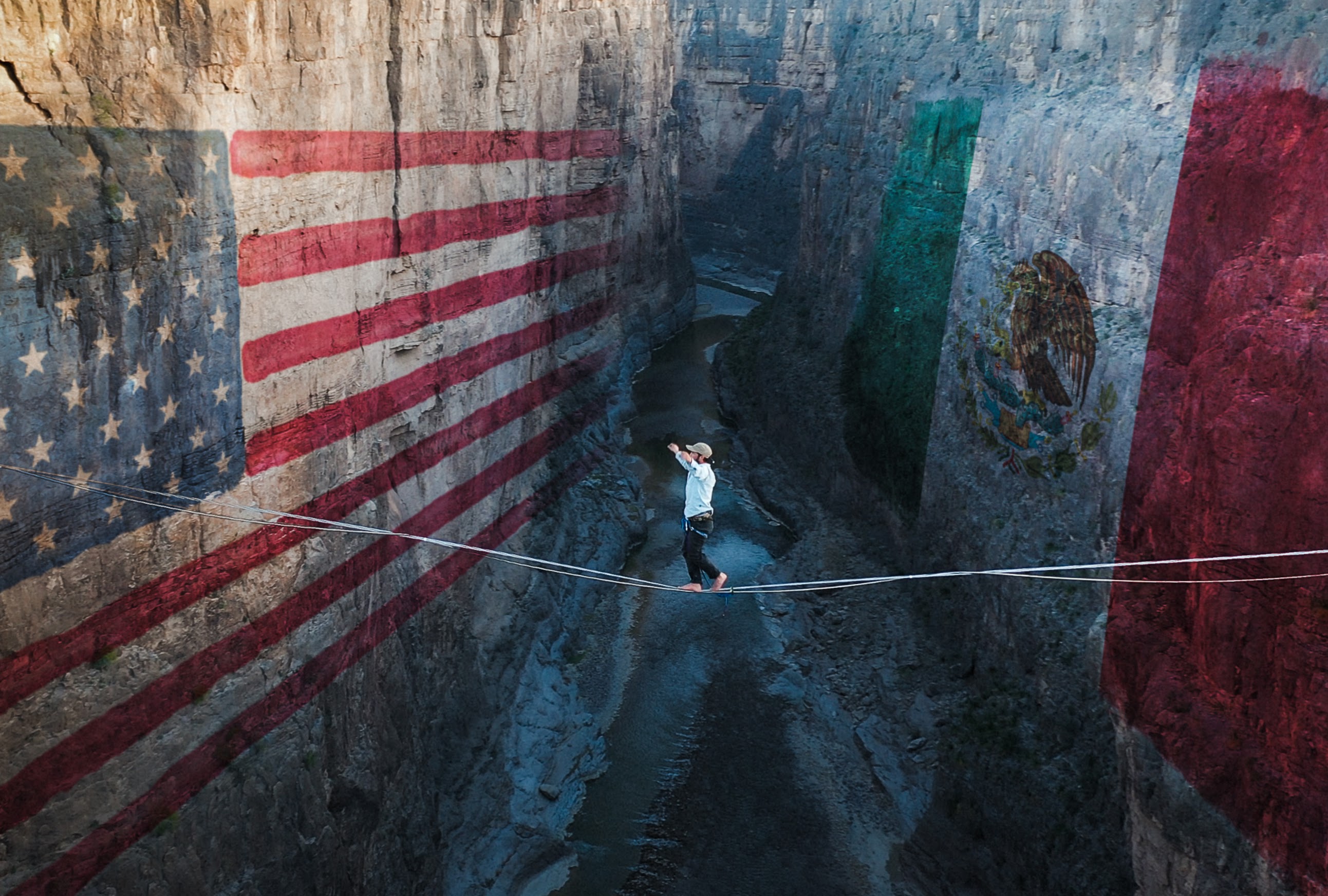
Back in January, as a standoff over funding for President Donald Trump’s Southern boarder wall led to a government shutdown, a filmmaker and a highline walker had an grand idea. They hatched a plan to create a dramatic artwork that would connect the the United States and Mexico with a slackline across the Rio Grande.
As debates over the perceived dangers of illegal immigration raged in Congress, two teams of highline experts from Mexico and the US met on the river, paddling together downstream some 20 miles into gorgeous Santa Elena Cavern, with its 1,500-foot-tall cliffs. There, they worked together to rig a highline some 500 feet in the air.
Two men crossed this precarious 300-foot-long bridge, Corbin Kunst from the Texas side, and Mexican slackliner Jamie Maruffo from the Mexican side.
“I don’t know if there could be a more powerful symbol of connection between two people, between two lands, than I could ever imagine,” filmmaker Kylor Melton, who documented the occasion in his film The Imaginary Line, told artnet News. The 11-minute short was released yesterday on YouTube.
Kylor Melton, The Imaginary Line a still shows Corbin Kunst walking a highline over the US and Mexico border in Santa Elena Canyon. Photo courtesy of Kylor Melton.
This isn’t the first work of art to connect the two sides of the border to make a political point. Earlier this summer, the architecture studio Rael San Fratello transformed part of the border fence into a row of see-saws, allowing children on either side to play with one another, in a temporary art piece titled Teeter-Totter Wall. It quickly went viral.
The idea of a slackline connecting the two countries had been on Kunst’s mind for years, since before Trump took office. (Popularlized in the 1980s, slacklining differs from the more famous tightrope in that it uses a length of flat webbing, rather than a wire cable, allowing the line to bounce around.) “I saw a picture of Santa Elena Canyon,” Kunst told artnet News. “I knew it would be perfect for a slackline—it’s just kind of screaming for one. And the fact that one side is Mexico and one side is the United States, to be able to literally connect the countries with a bridge, so to speak, really drew me in.”
When the debate over the border wall began to heat up, he decided to call Melton. It was the filmmaker who convinced Kunst that now was the time to make this dream a reality. “I really wanted this to be an art piece,” Kunst said. “Art is one of the greatest forms of resilience and resistance and also inspiration for people.”
The duo set to work planning for the action. It was crucial to have a representative from both countries walking the slackline, and to have teams from both countries rigging the line, illustrating the opportunity for connection and collaboration even as Trump was insisting on the need to erect barriers.
“I think of slacklining as a team sport,” Kunst explained. “You’re literally trusting your rigging team with your life, so I thought that would be a really powerful symbol to have a Mexican team and an American team building the slackline together.”
The Rio Grande forms the US-Mexico border while winding through the Santa Elena Canyon in the Big Bend region in Texas. Photo by John Moore/Getty Images.
To travel down the river, the US team secured a backcountry permit, but there is no equivalent recreational infrastructure on the Mexican side—the National Park Service website actually includes a notice warning of illegal border crossings in the Santa Elena Canyon, so Melton and Kunst consulted with lawyers to make sure they were acting in accordance with the law.
And even though the Park Service was closed during the shutdown, the project was careful to leave no trace—unlike visitors at other, more heavily touristed parks—securing the highline by slinging ropes around large, secure boulders. (The Mexican side of the line was secured with a bolt, after drilling a hole, which is legal in Santa Elena Canyon National Park.)
On January 25, the final day of the 35-day shutdown, Maruffo set foot on the slackline, making the precarious crossing high above the Rio Grande. Kunst followed. (Both were tethered to the line for safety.)
“There was this moment when Corbin said, ‘I’ve walked slacklines for years, but this is the first time slack line has actually meant something beyond myself,'” Melton recalled. “Rock climbing and base jumping and slack lining—these adrenaline pursuits are very self-indulgent, about pushing your personal limits. This slackline is about so much more than that.”
So far, Melton added, he’s been overwhelmed by reactions to the film, which he’s debuted the 5Point Film Festival in Colorado. “It’s such a simple idea, but the way that people have connected to it has been absolutely humbling,” he said. “I hope that the film is a piece of art that people can spark a conversation and encourage audiences to engage with these issues.”
Watch the film the Imaginary Line below.